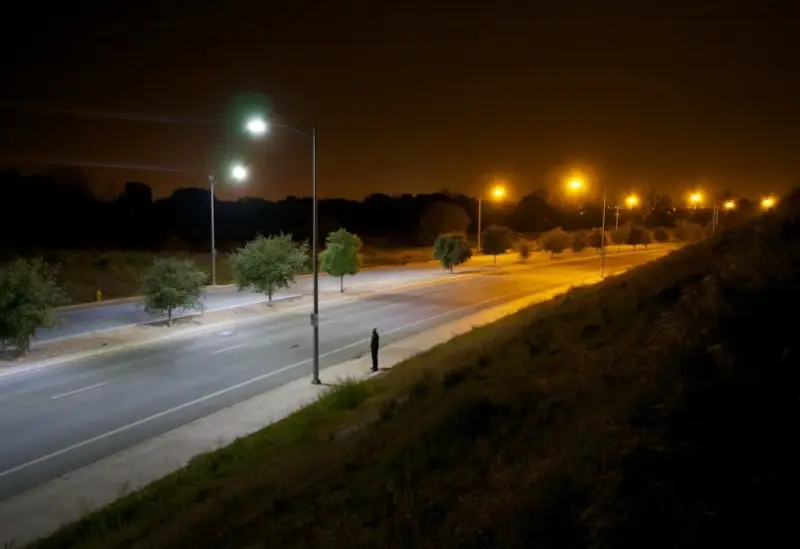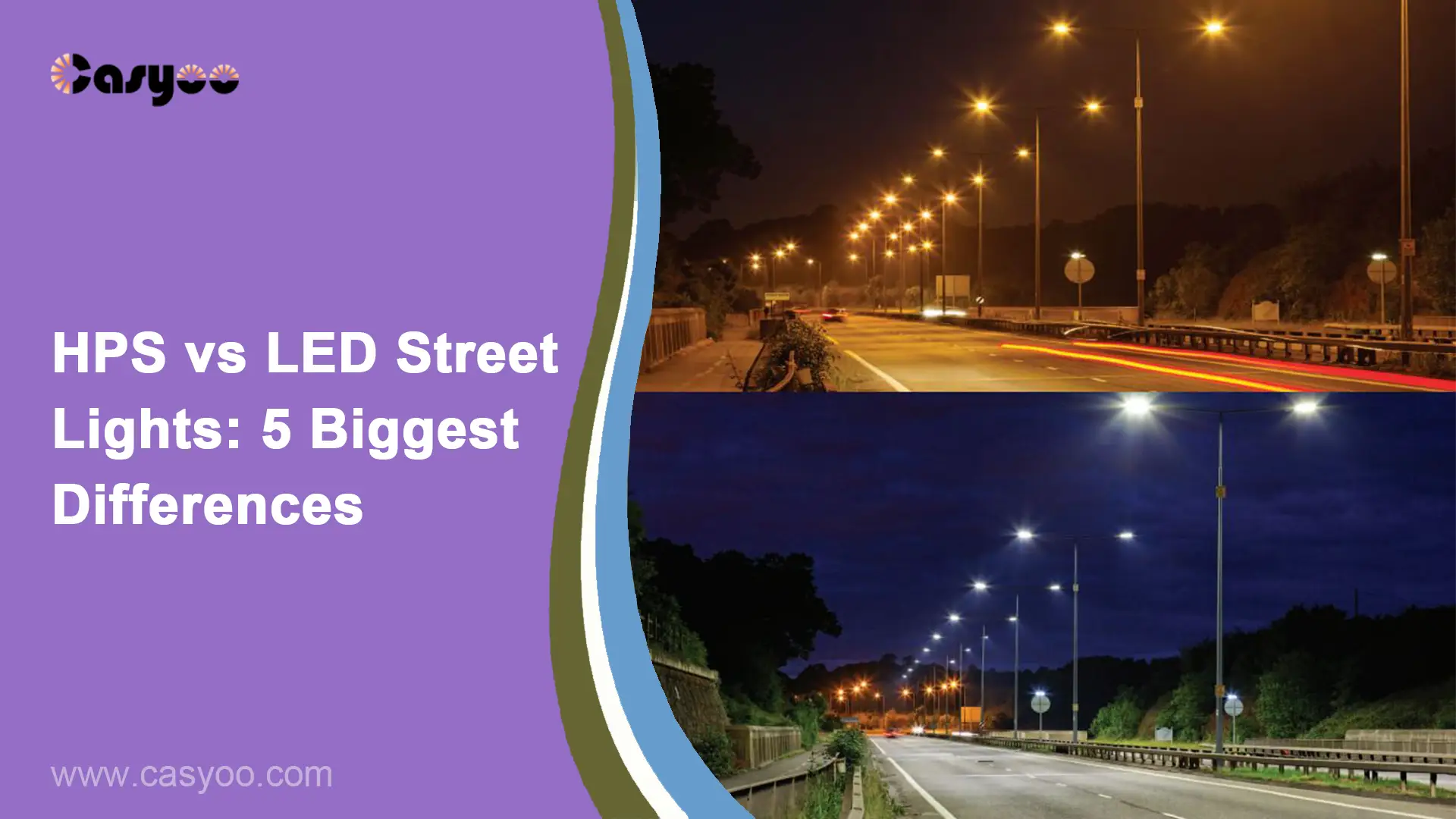HPS vs LED street lights, which is the better investment? Although HPS street lights are the traditional type on the streets, nowadays a lot of cities are replacing them with LED ones on a large scale. Is it worth embracing this trend and covering the costs of replacement? Here are the five most significant differences between HPS and LED street lights that will help you decide!
1. Efficiency and brightness
HPS street lights used to dominate in street lighting because of their ability to achieve a light efficiency of up to 90 lm/W. However, with the continuous advancement in LED light efficiency, HPS street lights have been losing their edge. According to the standards set by the European Union in 2021, LED lights with an “A” energy efficiency rating will exhibit an efficiency surpassing 210 lm/W.
Besides, the efficiency of HPS lights is more prone to being impacted by the circuits in comparison to LED lights in the following aspects:
- The power factor of LED street lights can reach 95%, while that of HPS lights is only 85%.
- LED does not require a ballast like the HPS street lights. A 400-watt HPS street lamp needs to work with a 34-watt ballast. Ballasts consume a lot of energy.
- Unlike LED lights, the circuits of HPS street lights are burdened with a high level of high-order harmonics. They not only cause additional power loss but also reduce the stability of the power grid.
When evaluating efficiency, we also need to consider the light distribution. HPS street lights require curved reflectors to concentrate light on the roads. In this process, a large proportion of light will be blocked or obsorbed. This results in the low light output efficiency of HPS street lamps, ranging from only 65% to 70%. On the other hand, LED street lights use secondary optical lenses, and their efficiency can reach about 80%. The efficiency can be further enhanced to 85%~90% with tertiary optical design.
Here is a table comparing 400 W HPS and 250 W LED street lights:
| Type | Rated power(W) | Efficiency(lm/W) | Light output efficiency(%) | Road utilization factor(%) | Luminous flux(lm) |
| HPS | 400 | 125 | 70 | 55 | 19,000 |
| LED | 250 | 90 | 80 | 90 | 16,000 |
2. Costs of HPS and LED street lights
Typically, the price of HPS street lights is around $50-$150, while LED street lights may cost $200-$500. This four-times more expensive price is one of the reasons that hinders the widespread transition from HPS to LED lights. But as LED technology keeps advancing, the price of LEDs will get lower and lower. What’s more, since LED lights can be 1.5 times more efficient than HPS lights, they save the costs in the long run:
- For installation, since the current of 400 W HPS street lights is higher than that of 250 W LED street lights, HPS lights need cables with a wider cable cross section, which cost more. It will be a big expense, considering how many cables are needed.
- LED street lights save the running costs because 250 W LED lights can almost ensure the same brightness of light as 400 W HPS street lights.
- LED street lights have a longer lifespan, so the maintenance costs are lower.
For the above reasons, despite the initial higher investment, LED street lights yield cost savings over time.
3. HPS vs LED street lights: Color temperature
The correlated color temperature (Tcp) of HPS lamps is about 3000 K, which is a warmer yellowish tone. Most LED street lights exhibit a color temperature exceeding 5300K. Research indicates that color temperature influences the luminous flux. Scholars from Fudan University pointed out that the human eye has cone cells (which determine the luminous flux under photopic vision conditions) and rod cells (which determine the luminous flux under scotopic vision conditions). The ratio of scotopic luminous flux to photopic luminous flux is the s/p value. CIE established a specialized technical committee (TCI-58) in 2000 to conduct research on s/p values. The following table shows the relationship between the s/p value and light sources with different color temperatures.
| Tcp | 3000K | 3200K | 5400K | 6500K | 2200K | 3000K | 2800K | 5300K | 11000K | 20000K |
| Light source | Tungsten halogen lamp | Fluorescent lamp | Fluorescent lamp | Fluorescent lamp | HPS lamp | Metal halide lamp | LED | LED | LED | LED |
| photopic luminous flux | 15 | 50 | 50 | 50 | 120 | 90 | 50 | 50 | 50 | 50 |
| scotopic luminous flux | 26 | 64 | 96 | 104 | 78 | 111 | 59 | 93 | 141 | 134 |
| s/p | 1.71 | 1.28 | 1.91 | 2.07 | 0.65 | 1.23 | 1.17 | 1.86 | 2.81 | 2.67 |
From the table, we can tell that an LED with a color temperature of 5300 K is three times brighter than the 2200 K HPS lamps. So 5300 K LED lights with lower power can provide the same level of luminance as 2200 K HPS lights and save energy. In addition, a higher color temperature can also keep people alert and ensure safety.

4. How long do HPS and LED street lights last?
Theoretically, the light decay of HPS lights is about 30% after 3,000 hours, while LED lights experience only about 5% light decay after 10,000 hours. The lifespans of HPS lights and LED lights are, respectively, 5,000-15,000 hours and 30,000-50,000 hours. However, in actual use, they tend to grow significantly dimmer to the naked eye, and some burn out after 6 months. The average lifespan is 1 year. Moreover, the number of times of switching on and off HPS lights is limited. Generally, they can only be switched on and off 4,000 to 5,000 times. After that, it will be difficult to turn them on.
As for LED lights, the light decay measured by a tester is only about 8% after one year of use, and the changes are nearly imperceptible to the naked eye. After 4 to 6 years, most LED lights are only affected by light decay until they are not bright enough and have to be replaced. According to this, the service life of LED street lamps is 4–6 times longer than that of HPS lights. In other words, you will only need to replace LED lights once when you have replaced HPS lights four to six times. The maintenance cost of HPS lamps will be higher, and because the replacement process of street lamps is complex, it will also need more manpower in total.
5. HPS vs LED street lights: Warm-up time
It takes tens of seconds, or even ten minutes, for the HPS lights to warm up and stabilize. This is because during the start-up process, the sodium vapor in the bulb needs to be heated to a sufficiently high temperature for light emission. Once you turn off the lights, you need to wait 3 to 6 minutes for them to cool before restarting. The warm-up process is part of the design of the HPS lights to ensure they can function properly and provide the required luminance.
When current passes through the LED, carriers combine between the two semiconductor materials and emit light. This is completely different from the working principle of HPS lights. Therefore, LED lights need no warm-up duration and can start working right away.
Conclusions
This passage introduces the five biggest differences between HPS and LED lights: efficiency and brightness, costs, color temperature, lifespan, and warm-up time. LED street lights surpass HPS street lights in various aspects and are the preferred choice for the coming future. Find the best HPS equivalent LED lights at Casyoo and save your money from this moment!





